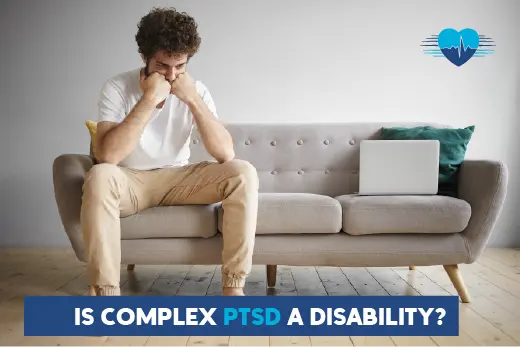What is Complex PTSD?
Complex PTSD is a term used by doctors to describe a condition in people who have been through many difficult traumatic experiences.
The reasons for having complex PTSD can come from being neglected, poorly treated, or experiencing abuse and violence.
Some things that can make complex PTSD worse include:
- Having an unhappy and rough childhood.
- Going through difficult situations caused by a parent or someone caring for you.
- Dealing with upsetting events for a long time.
- Staying in touch with someone who hurts you.
Sometimes, the reasons for or the results of complex PTSD can stay hidden for a long time.
This means people find it hard to deal with the conditions in their work and personal lives.
Symptoms of Complex PTSD
People with complex PTSD may have additional symptoms along with those seen with regular PTSD. It includes:
- An inability to control emotions—feeling intensely emotional for a long time.
- Emotional dysregulation.
- Getting flashback and nightmares.
- Hyperarousal and feeling on edge.
- Seeing yourself as flawed, guilty, or unworthy.
- Not having a clear sense of who you are.
- Staying away from things that remind you of the trauma.
- Believing the world is unsafe and not trusting others.
- Feeling as if life has no purpose at all.
- Not being able to form and keep healthy relationships.
People dealing with PTSD or complex PTSD might also face:
- Changes in beliefs and outlook: People with either condition may adopt a negative outlook on the world and its inhabitants, leading to a loss of faith in previously held beliefs.
- Detachment from the trauma: Some survivors might completely forget the traumatic events.
Causes of Complex PTSD
People with complex PTSD often go through long-lasting trauma, such as continuous physical, emotional, or sexual abuse.
Other situations that can lead to complex PTSD include:
- Being a victim of human trafficking.
- Being held captive or experiencing prolonged hostage situations.
- Serving as a prisoner of war.
- Living in an area affected by war.
As complex trauma usually lasts for an extended period, it often begins during early childhood.
These distressing childhood encounters, also referred to as adverse childhood experiences (ACEs), can involve:
- Exposure to violence, abuse, or neglect during childhood.
- Growing up in a dysfunctional family or community.
- Suicide in the family.
- Substance dependence in the family.
- Mental health disorders in the family.
- Having family members in jail.
- Persistent poverty or neglect.
- Unstable housing.
- Growing up in an unsafe or crime-prone environment.
Approximately 61% of surveyed adults in U.S revealed they had encountered at least one adverse childhood experience (ACE).
One in 6 individuals mentioned they had faced four or more ACEs.
Facing certain situations doesn’t automatically mean someone will have complex PTSD.
However, if a person has gone through more difficult experiences during childhood (ACEs), there’s a higher chance they might develop it.
Is Complex PTSD (CPTSD) classified as a disability?
In some cases, CPTSD can be considered a disability, especially if its symptoms are long-term and severe enough to affect a person’s functioning.
This question also examines the complexities surrounding mental health.
Especially for those grappling with CPTSD nightmares and the symbolic weight that the condition often carries.
Nightmares are a distinctive feature of CPTSD, intensifying the challenges faced by people already navigating the intricate landscape of this mental health condition.
These vivid dreams underscore the urgency of understanding whether CPTSD is a disability.
CPTSD as a Disability
There are cases in which the Social Security Administration (SSA) considers PTSD to be a disability.
If PTSD meets certain criteria in the SSA’s Blue Book, a person may be able to file a claim for disability benefits.
People suffering from symptoms consistent with CPTSD may still be eligible to file a claim for disability benefits if they meet specific criteria outlined by the SSA.
While the SSA primarily recognizes Post-Traumatic Stress Disorder (PTSD), which involves specific criteria related to trauma exposure and its effects, those with CPTSD symptoms may find eligibility if their condition aligns with the following standards:
- Medical documentation of prolonged exposure to traumatic events — including but not limited to ongoing interpersonal trauma, emotional abuse, or neglect.
- Persistent and pervasive symptoms that may include:
- Re-experiencing trauma through intrusive memories, flashbacks, or nightmares.
- Avoidance of reminders of the traumatic events.
- Disturbances in mood or behavior.
- Challenges in interpersonal relationships and social interactions.
- Cognitive difficulties, such as problems with concentration and memory.
- Functional impairment — peoplemust demonstrate a significant limitation in at least two of the following areas of mental functioning:
- Understanding, applying, and remembering information.
- Interacting with others.
- Concentrating, persisting, or maintaining pace.
- Adapting or managing oneself.
- Chronicity and Severity — the requirement is for the condition to be both severe and enduring, supported by documented evidence of continuous medical treatment, psychotherapy, psychosocial assistance, or involvement in a structured environment designed to alleviate symptoms over a prolonged period.
It’s essential to note that CPTSD is not explicitly listed in the SSA’s Blue Book, and eligibility may depend on the alignment of symptoms with the general criteria for mental health disabilities.
People contemplating applying for disability benefits because of CPTSD should consult with mental health professionals and legal experts who are well-acquainted with the SSA’s procedures.
What’s the Contrast Between Complex PTSD and PTSD?
PTSD often comes from one tough event, while C-PTSD is connected to ongoing or repeated situations.
A notable difference lies in how they are treated.
PTSD is handled with therapy that focuses on the trauma, like eye movement desensitization and reprocessing (EMDR) or cognitive-behavioral therapy (CBT).
CPTSD gets treated with similar methods, but there’s extra attention to learning strategies, like dealing with feelings or building supportive relationships
Is PTSD Neurodivergent?
PTSD can occasionally be considered to fall under the category of neurodivergence.
Then again, it should be noted that PTSD is an acquired and situational condition, that is, it results from specific traumatic experiences and is often treatable through the right treatment.
Considering whether CPTSD is a type of neurodivergence broadens the conversation around mental health, recognizing the diversity of experiences within the spectrum.
How to Explain CPTSD to Someone Who Doesn’t Have It?
Effective communication is important when discussing CPTSD with those unfamiliar with the condition.
This offers practical tips for communicating CPTSD to increase understanding and support in relationships.
How Do Doctors Diagnose Complex PTSD?
ICD-11 sets criteria for Complex PTSD diagnosis, building on traditional PTSD criteria.
A person shows self-regulation issues, low self-esteem, shame or guilt from past trauma, and relationship challenges.
Before CPTSD, clinicians used terms like enduring personality change or extreme stress disorders.
CPTSD aims to replace these.
Clinician awareness of PTSD vs. CPTSD differences is growing.
However, due to CPTSD being new, some may choose alternative diagnoses, like borderline personality disorder (BPD).
CPTSD and BPD share similarities, but they differ.
In 2022, it was highlighted that CPTSD leads to consistent negative self-views, while BPD involves unstable self-conceptions.
Those with CPTSD struggle in relationships, avoiding connections.
BPD causes oscillations between idealizing and undervaluing others, creating relationship challenges.
Importantly, someone might have both BPD and CPTSD simultaneously, complicating the diagnostic process for CPTSD.
Treatment of Complex PTSD
Helping with Complex Post-Traumatic Stress Disorder (CPTSD) often needs a personal touch, looking at the person’s history of tough experiences.
Treating this type of PTSD might take more time and involve different kinds of help compared to regular PTSD, especially when dealing with problems in how a person organizes.
There are many ways to help with CPTSD.
Psychotherapy
- Psychotherapy can be conducted individually or in a group setting.
- Initially, therapy aims to make the person stable, deal with emotions, improve relationships, and establish coping strategies for flashbacks and anxiety.
- Approaches concentrating on trauma, such as Cognitive Behavioral Therapy (CBT) or Dialectical Behavioral Therapy (DBT), could be applied.
Eye Movement Desensitization and Reprocessing (EMDR)
EMDR is a technique designed to help people with PTSD or CPTSD.
- Following the preparation phase, the therapist directs the individual to remember traumatic memories while moving a finger from side to side, and the person tracks this movement with their eyes.
- The process aims to desensitize the individual to the trauma, eventually enabling them to recall the memory without a strong adverse reaction.
- While stirring debate, specific guidelines, such as those from the American Psychological Association, suggest EMDR under specific conditions while recognizing the necessity for additional research.
Prolonged Exposure (PE) Therapy
- PE is a mode of therapy for PTSD and is part of CBT.
- It tackles the issue of people with PTSD unconsciously avoiding reminders of traumatic experiences.
- PE seeks to reduce avoidance of traumatic memories and help individuals have less severe reactions to triggers.
- It typically involves two parts: imaginal exposure, where traumatic events are discussed with a therapist in the present tense. Furthermore, there is in vivo exposure, where the individual encounters triggering stimuli in real-world situations as outlined in an agreed-upon plan with the therapist.
It’s important to note that the effectiveness of these treatments will vary from person to person.
A collaborative approach between the person and their healthcare provider is important in determining the most suitable treatment plan.
Additionally, ongoing research contributes to a better understanding of these therapeutic modalities and their effectiveness for CPTSD.
Final Thoughts
Complex Post-Traumatic Stress Disorder (CPTSD) arises from prolonged exposure to trauma, impacting various aspects of life.
The Social Security Administration (SSA) believes PTSD to be a disability in certain cases.
People with CPTSD symptoms can qualify for benefits based on specific criteria.
Today Telemedicine is a prominent telemedicine provider committed to meeting mental health requirements.
We offer convenient virtual consultations with mental health experts, providing custom help and treatment for conditions like CPTSD.
We strive to make society healthier by providing innovative telemedicine solutions for your mental health.
FAQs
Q: Is CPTSD considered a disability?
The Social Security Administration (SSA) does not have a specific category for CPTSD, but people with symptoms may still be eligible for disability benefits based on specific criteria.
Q: How is CPTSD different from PTSD?
PTSD results from a single tough event, while CPTSD is connected to ongoing or repeated situations.
Q: What are the symptoms of CPTSD?
Symptoms can include:
- Avoiding trauma reminders.
- Emotional dysregulation.
- Re-experiencing the trauma.
- Disturbances in mood or behavior.
- Cognitive difficulties.
- Issues related to interpersonal relationships.
Q: What are the best strains for CPTSD and anxiety?
Cannabis strains are recognized for their potential therapeutic effects in managing CPTSD and anxiety.
It’s important to approach such remedies responsibly and in consultation with healthcare professionals.
Q: Finding jobs for people with CPTSD.
People with CPTSD can benefit from assistance with employment concerns and job opportunities.
From flexible work arrangements to roles in counseling or creative pursuits, the goal is to enable people to pursue fulfilling and supportive employment.





